Just over a month after their EFL third-round defeat against Arsenal at the Emirates Stadium, Leicester City traveled back to north London, this time for a Premier League clash. It was anticipated to be an enticing tactical battle between two sides that looked to outwit each other in a bid to qualify for the Champions League next season.
With three wins out of five, Arsenal sat 5th in the league table before the game. The Gunners were coming from a hard-fought win in their midweek’s Europa League fixture. The visitors, on the other hand, had acquired the same number of points as the hosts but were sitting just above them due to a higher goal difference.
Brendon Rodger’s men came into the game on the back of consecutive home defeats in the league. Moreover, Leicester City hadn’t won an away game against Arsenal since 1973. Hence, the odds favored the home side before the game. However, the ex-Liverpool manager masterminded a hard-fought 1-0 victory to get back to the winning ways in the league.
In this tactical analysis, we will demonstrate the tactics used by both the managers. Besides, we will analyze the pragmatic approach that Rodgers utilized to outplay his counterpart.
Lineups
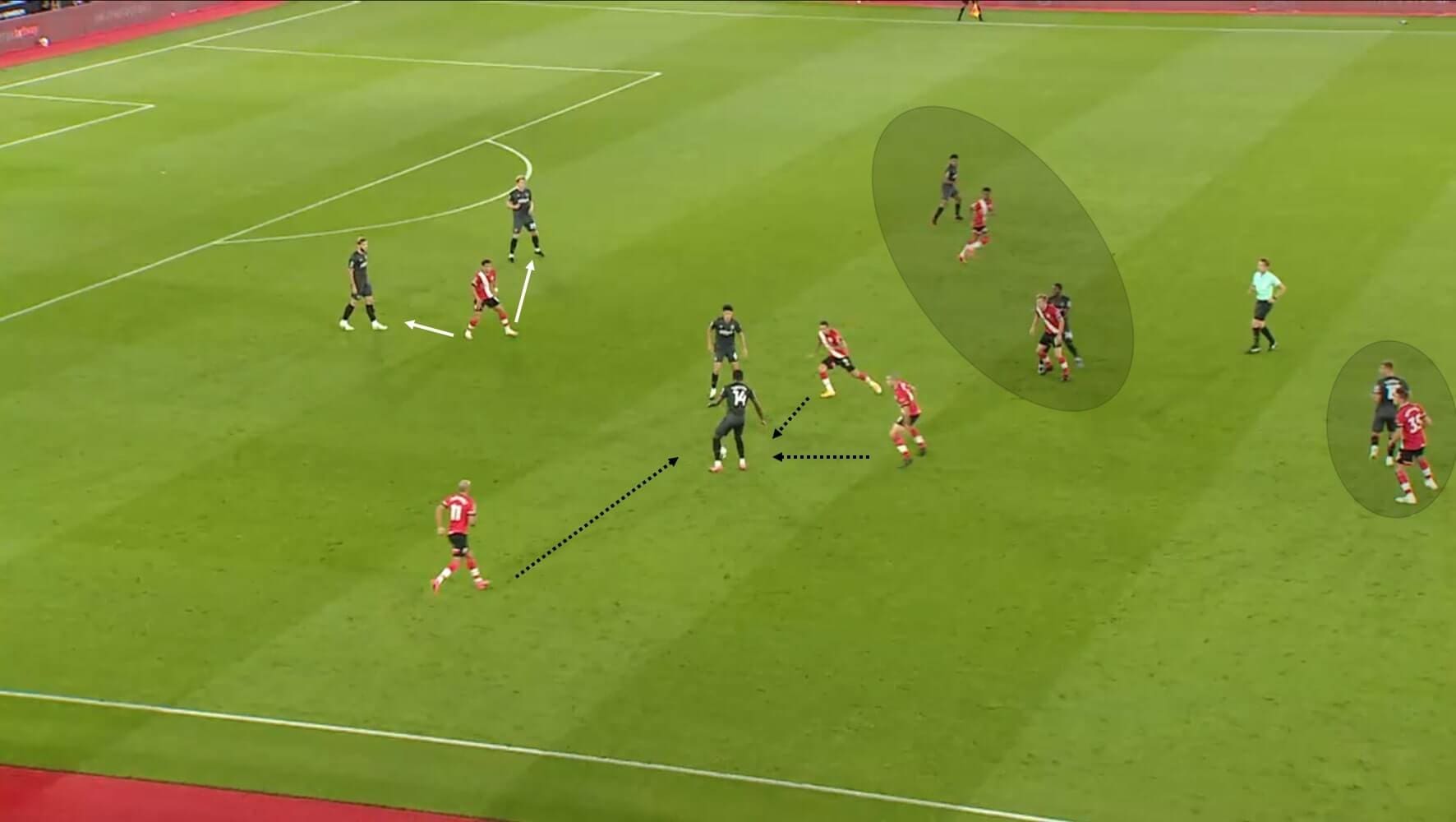
Mikel Arteta shuffled his side to include the new £45 million signing Thomas Partey as the Spaniard made two changes from their previous league game. With Partey in the central midfield alongside Granit Xhaka and Dani Cabellos, Bukayo Saka was reinstated in the forward line on the left as it meant that Pierre-Emerick Aubameyang was shifted to the right in place of Nicholas Pépé. Alexandre Lacazette replaced Willian in the center as he was the final change in Arsenal’s 3-4-3 formation on-paper which looked like a 4-3-3 on the field.
Leicester implemented the three-at-the-back formation for the third time this season as Rodgers also made two changes from the previous league game. James Maddison started for the first time in the new league campaign as he looked to ease the creative issues for his team. He replaced Ayoze Pérez, who has had a poor start to the season so far. Christian Fuchs also started for the first time in the league as he replaced Kelechi Iheanacho, who was benched for this game. Jamie Vardy returned to the bench after missing out on the previous two games with an injury. In the absence of a recognized number ‘9’, Harvey Barnes started as the lone striker.
Leicester’s defensive approach for the first-hour mark
Rodgers took a leaf out of his team’s victory against Manchester City during the last month as the Irish manager set his team up in the same way against an Arsenal side who, like City, tends to dominate games using a positional style of football.
Leicester were set up in a defensive back-five system without the ball which was horizontally and vertically compact. It started with a 5-3-2 mid-block during Arsenal’s first phase of the buildup and transitioned into a 5-4-1 low-block as the Gunners progressed the ball through thirds.
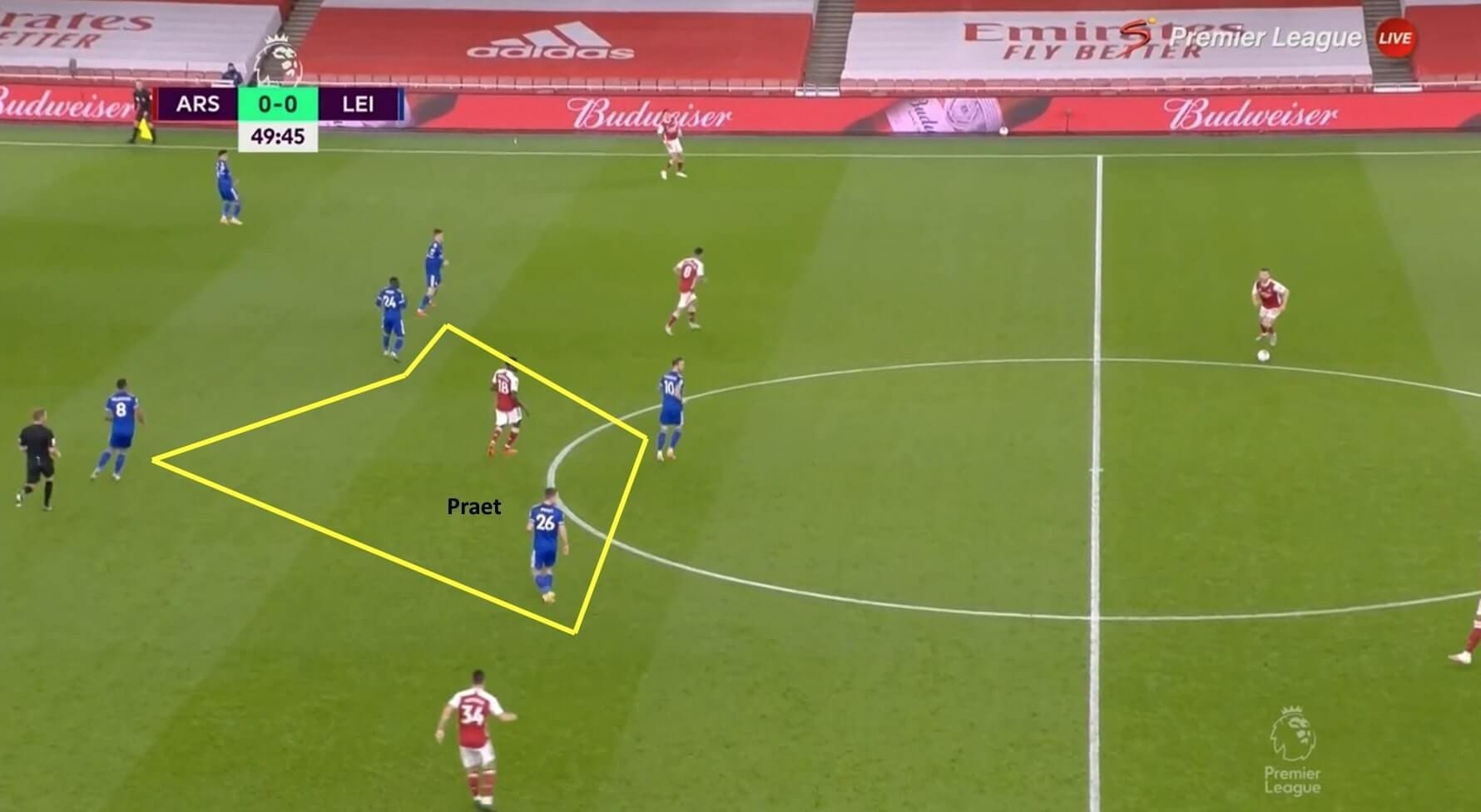
The above image shows Leicester’s initial 5-3-2 block as Arsenal’s centre-back attempts to form an attack from his own half. Observe the 3-2 shape of the visitors’ midfield and attacking lines as they formed a pentagon in the centre. The primary objective of this pentagon was to prevent the progression of the ball through the middle and invite the hosts to attack from the wide areas.
This takes us to Leicester’s well-calculated pressing plan for this game. Notice in the previous figure that the Foxes were disinterested in pressing the man in possession. This is because Rodgers had instructed his side to refrain from pressing in the central areas during the opponent’s initial phase to maintain their defensive shape in the center. However, as soon as the ball was progressed into the wide areas, Leicester’s wide players would engage in a press to congest the inside space and passing angles, as shown in the figure below, which was few seconds after the previous image.
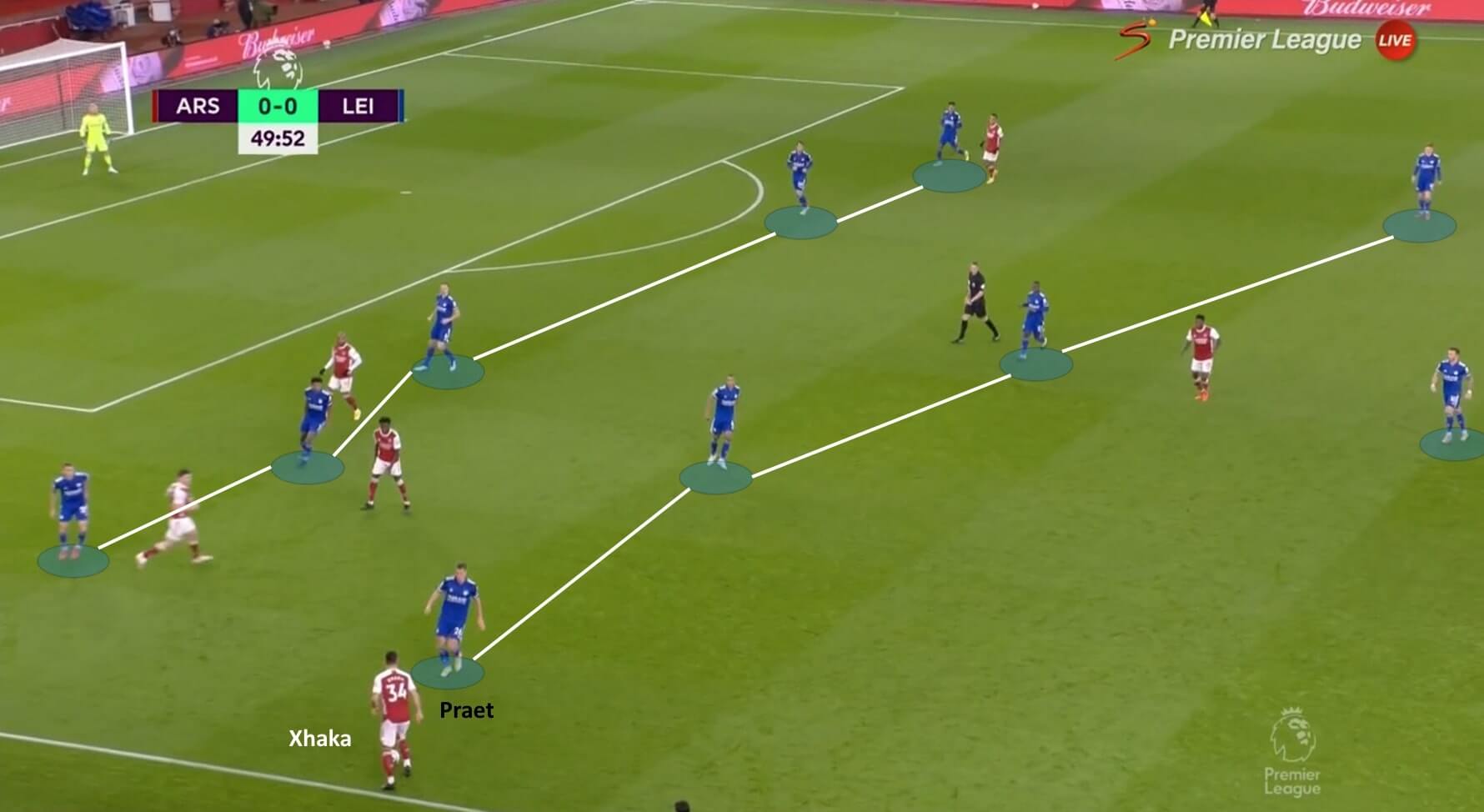
As Arsenal tried to enter the final third from the flank, Dennis Praet (#26 in the previous image) had dropped as a wide midfielder to form a 5-4-1 block which had pushed deep into a low-block. Not only that, he started to press Xhaka as the Leicester lines made lateral movements to maintain their compactness. Observe that Xhaka does not possess a lot of passing options as the ball-sided midfield and defensive players have congested nearby spaces.
On the ball, the Foxes created a 2-4-3-1 shape as Fuchs became the left-back and pushed into the midfield line, allowing James Justin to push higher into the opposition half. Timothy Castagne also pushed into the midfield line from the other side to make a four-man midfield with the two pivots. The structure is shown in the figure below.
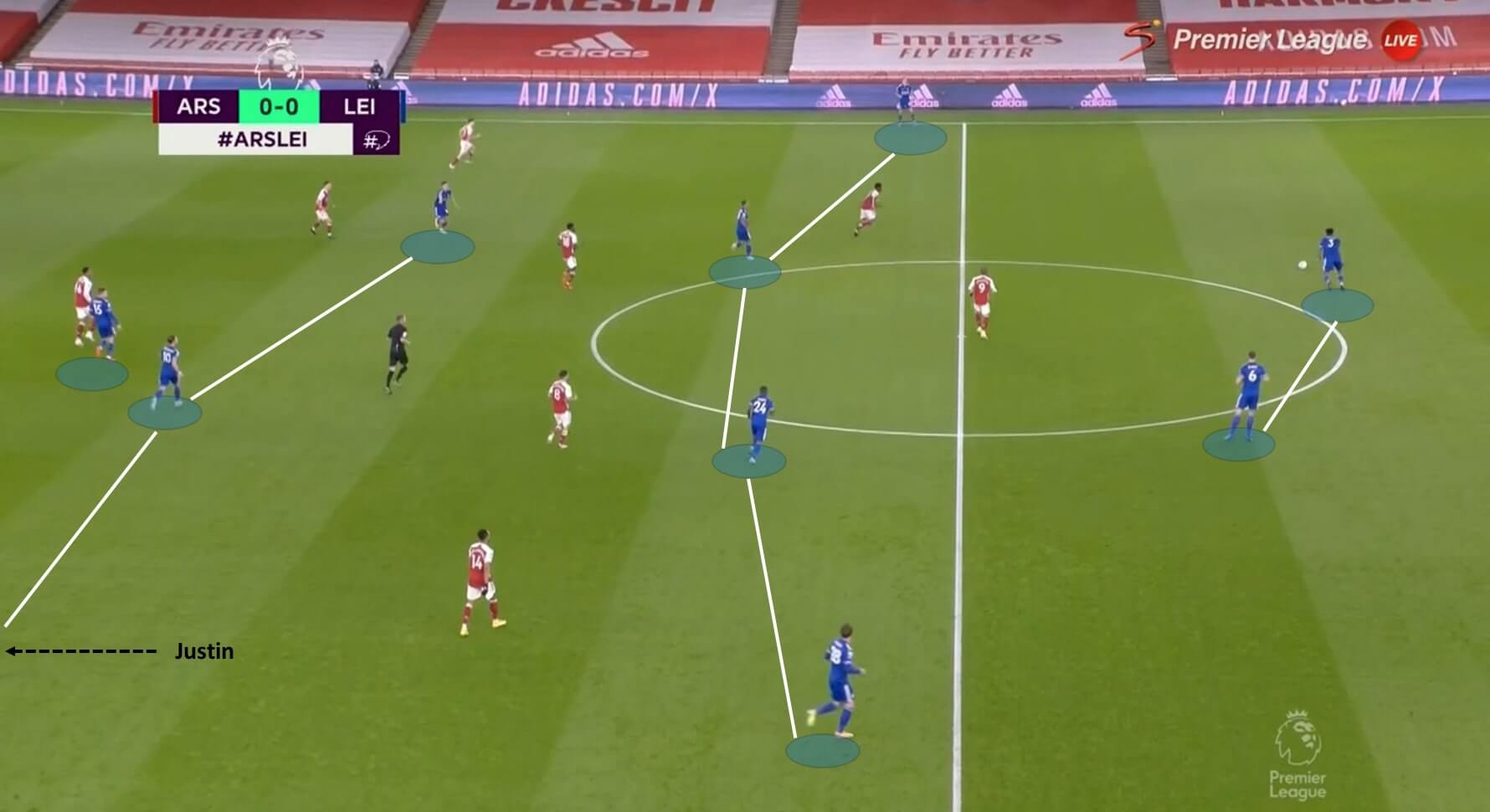
53% of Leicester’s attack came from the left as they primarily targeted the left side of the pitch to hurt Arsenal. The reasoning for this lied in their attacking shape. The combination of Justin, who pushed higher than Castagne on the left, and Maddison, who looked to occupy the left half-space (shown in the figure below), provided more bodies and creativity down the left.
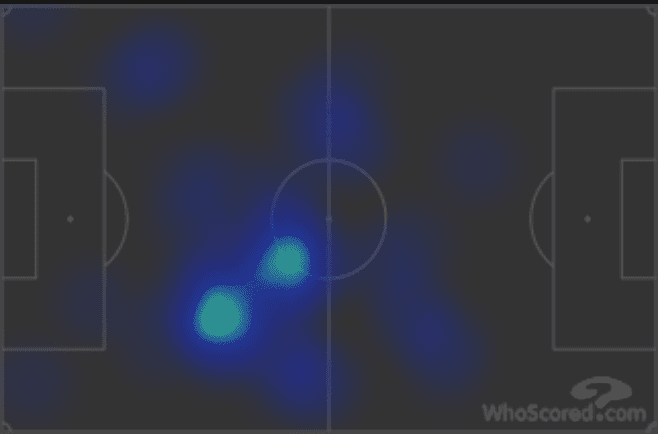
Also, the visitors abstained from playing out from the back. Rather, they looked to go direct during the buildup more often. Kasper Schmeichel being right-footed was able to launch better balls towards the left, as the following passing map indicates the captain’s inclination to build from the left.
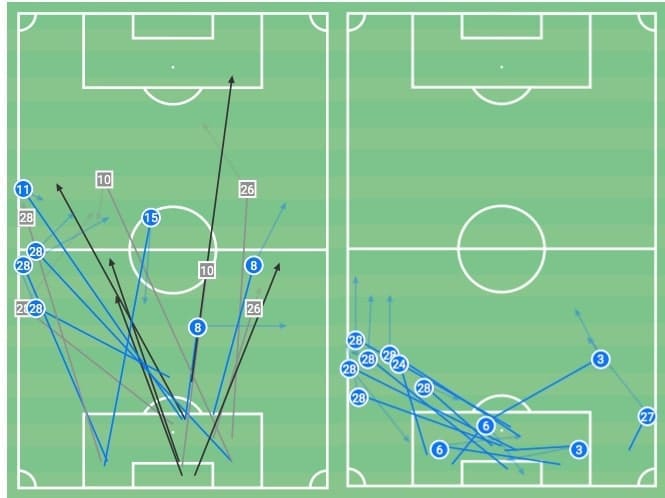
Leicester’s pressing intensity (PPDA) during the first half was 34.2 which suggests that they allowed Arsenal to make over 34 passes before taking defensive action. It clearly indicates Leicester’s passive approach towards the game as they prioritized the defense in the first hour of the game. Rodgers’ men were successful in implementing the tactic as Arsenal never tested Schmeichel on goal even though they enjoyed 58% possession and created 11 shots in the first hour of the game.
Arsenal lacked ideas to break Leicester’s resolute defense
Arteta likes his Arsenal to play a positional style of football. One of the important aspects of this style is to occupy all the vertical channels across thirds in order to stretch an opponent horizontally. Hence, the hosts transitioned into a 2-3-5 shape with the ball where the front-five positioned themselves in all the vertical channels, as shown in the figure below.
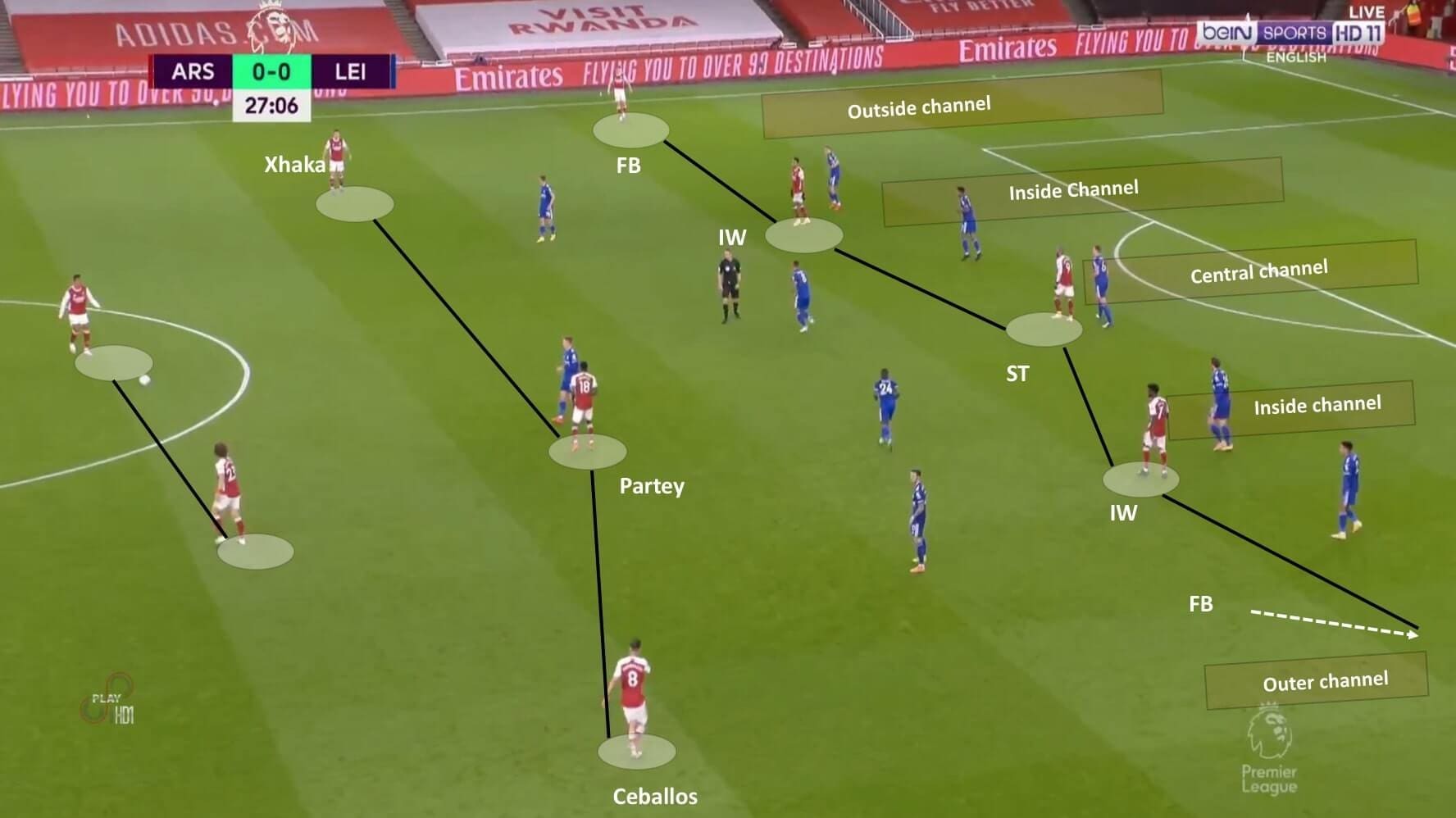
The full-backs pushed into the final third to provide the width and occupy the wide channels. The inverted-wingers tucked inside to occupy the half-spaces (inside-channels) while the remaining central channel was then filled by the striker. Behind the attacking line, Partey was the lone central midfielder as Xhaka and Dani Ceballos split wide to become makeshift full-backs to provide cover in the outer channel in case of a counter-attack from Leicester.
With Leicester implementing a defensive system, the creative onus was on the home side. When an opponent defends narrowly in a low-block, it is important to rely on quick switches of play, one-two passing combinations, and cohesive off-the-ball movements from the front line to defy the compactness. Unfortunately, Arteta’s men lacked creativity in the attack and seldom demonstrated any of those plays which made it difficult for the men in red and white to create any penetration in the final third. They not only moved the ball slowly but did not create smart off-the-ball movements to maneuver the Leicester lines and create gaps. The following few figures highlight the issue.
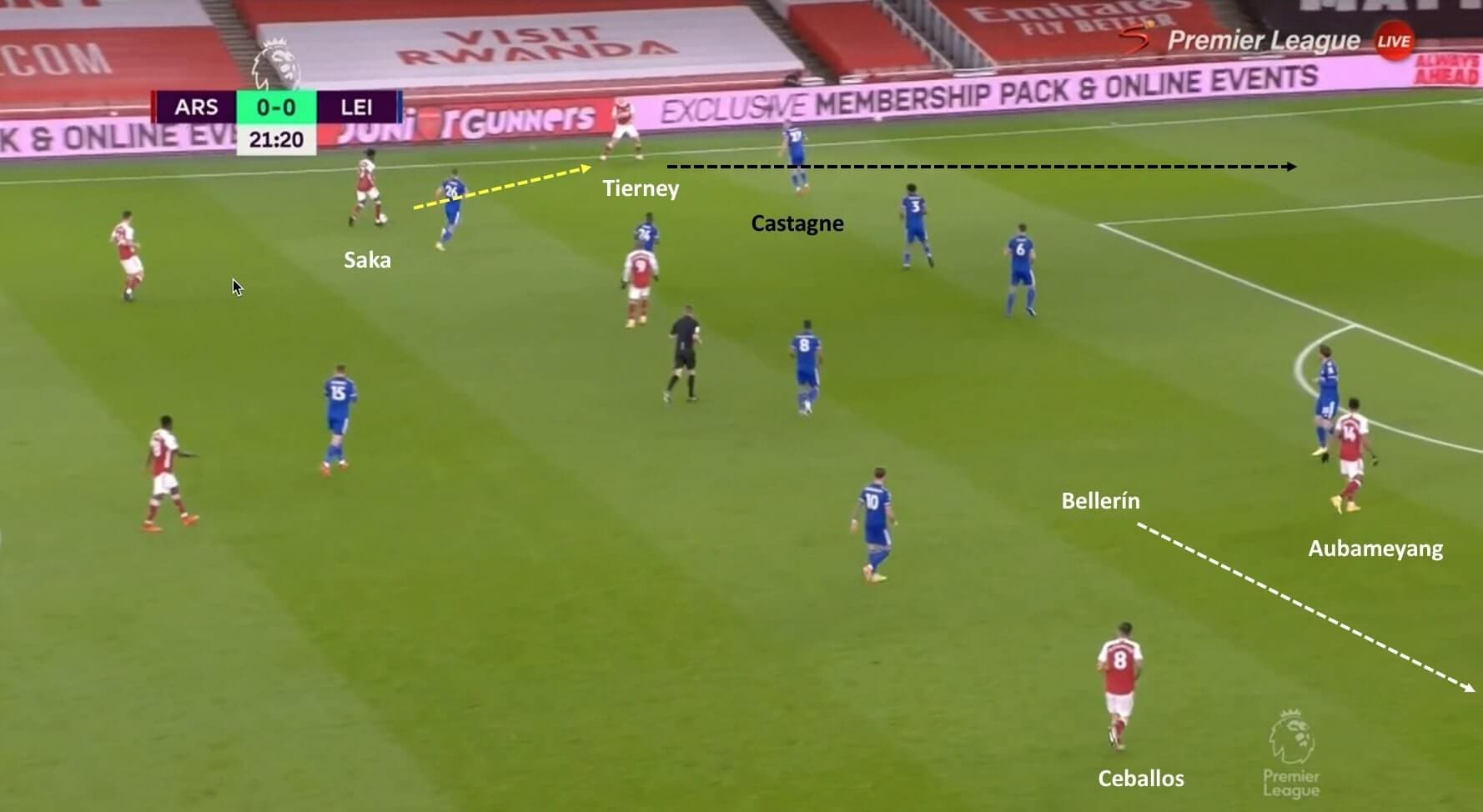
The figure above shows a moment in the game when Leicester lines had drifted towards their right as Arsenal carried an attack from that side. Albeit there was no space between the lines, a quick switch of play from this point could have isolated Leicester’s left-sided defense in a three-versus-three situation as Héctor Bellerín (not in the image) was occupying the wide space on the right while Ceballos and Aubameyang also hovered around the inside channel. However, Saka continued the play down the left and although Arsenal created a chance, it was only because of Kieran Tierney’s brilliant movement to skip past Castagne to provide a cross in the box.
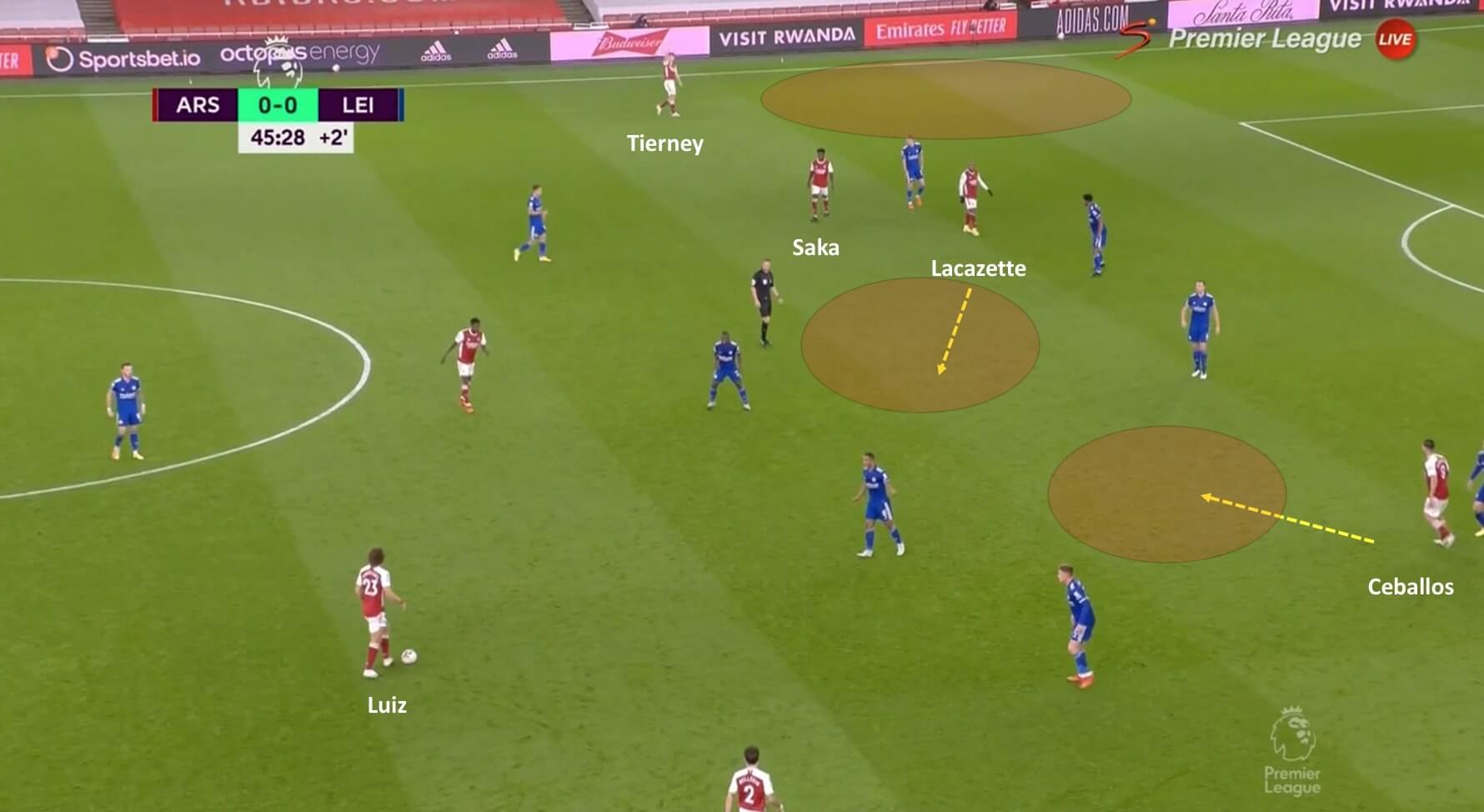
The above snapshot highlights another instance of a lack of quick movements from Arsenal’s forward line. Even though Saka’s slight inward movement created space on the outside for Tierney, it was the least creative option as the long-distance would provide time for the Leicester lines to drift towards the right. One of the alternatives could have been Ceballos drifting inside from the right to create the space outside for Bellerín. Since it would have been on David Luiz’s side, it would have created the attack quicker. Another option was that Lacazette could have dropped between the lines to create a one-two passing combination with the narrow attackers to attack the space beyond the backline. However, the forward line of Arsenal was pretty much static which fizzled out the attack.
Most of Arsenal’s creativity came from Luiz as the centre-back provided dangerous deliveries in the final third. The Brazilian, who only played for 49 minutes, attempted 17 attacking third passes (with 76.47% accuracy), which was highest amongst all the players on the field. Leicester’s lack of press allowed the ex-Chelsea man to have time on the ball which he made good use of as the following sequence of images showcases the range of creative long balls that Luiz provided which created most of the chances for the home side.
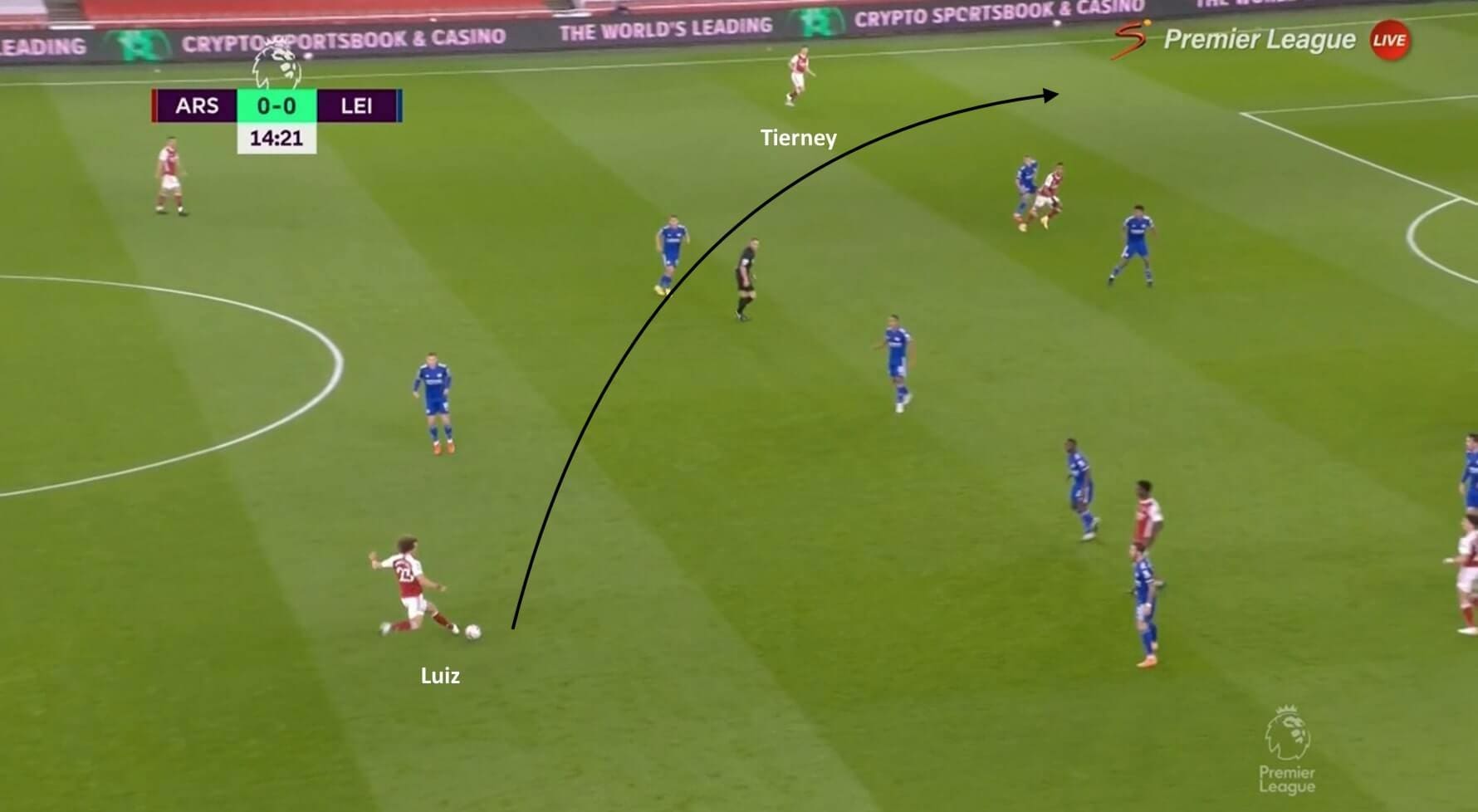
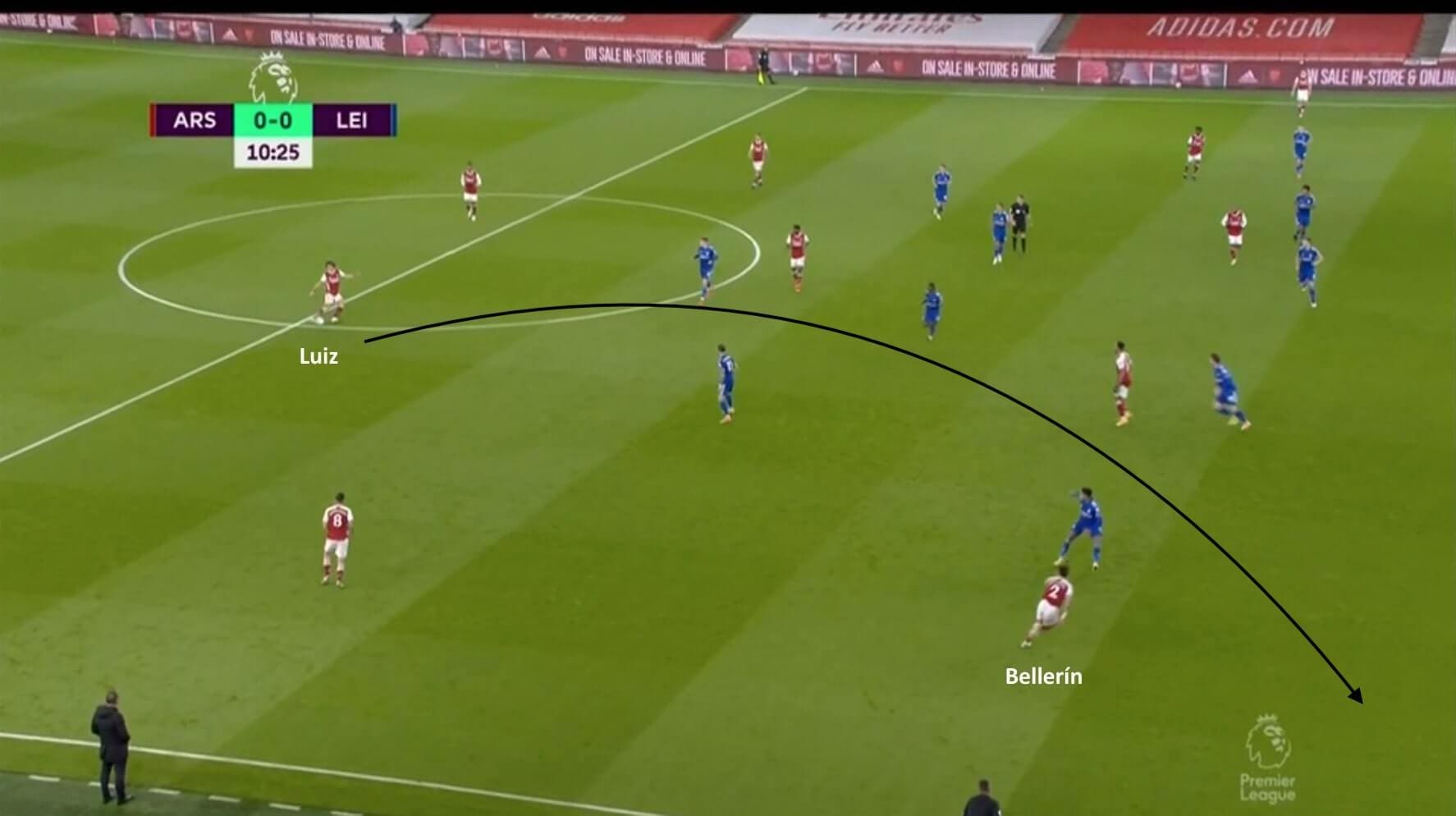
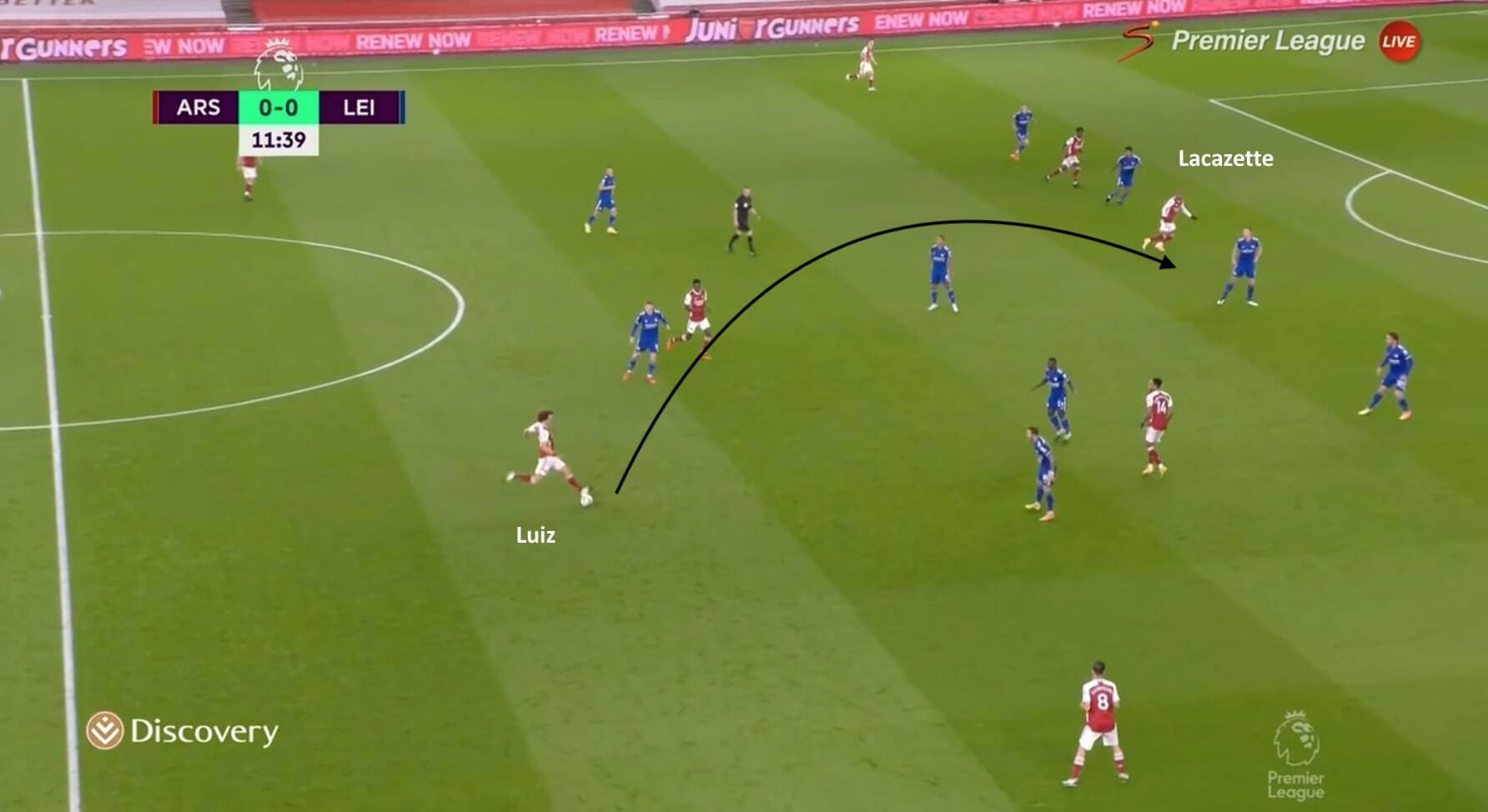
The following passing map of Arsenal also further provides evidence that the Gunners lacked movements in the opposition half. The following figure shows Arsenal’s passing map. The thicker the lines between two points (players), the more passes exchanged between them. As you can see, most of the passes are amongst the deepest players while there are very few passes higher up the field.
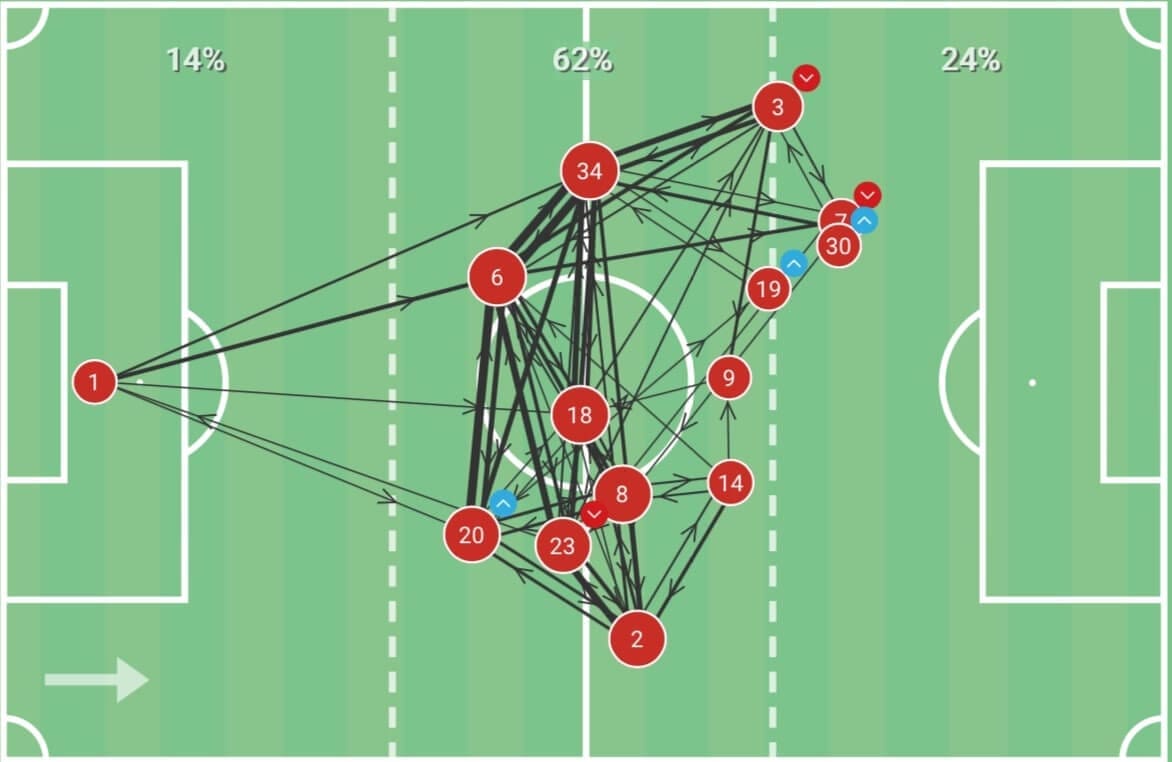
Luiz’s injury four minutes into the second half spurred a concern as Arteta looked for a new creative spark from his team. Alternatively, Arsenal began to create overloads in the left outer channel to expose the space behind the Leicester backline on the flanks to further provide a cross inside the box. The following couple of figures showcases exactly that.
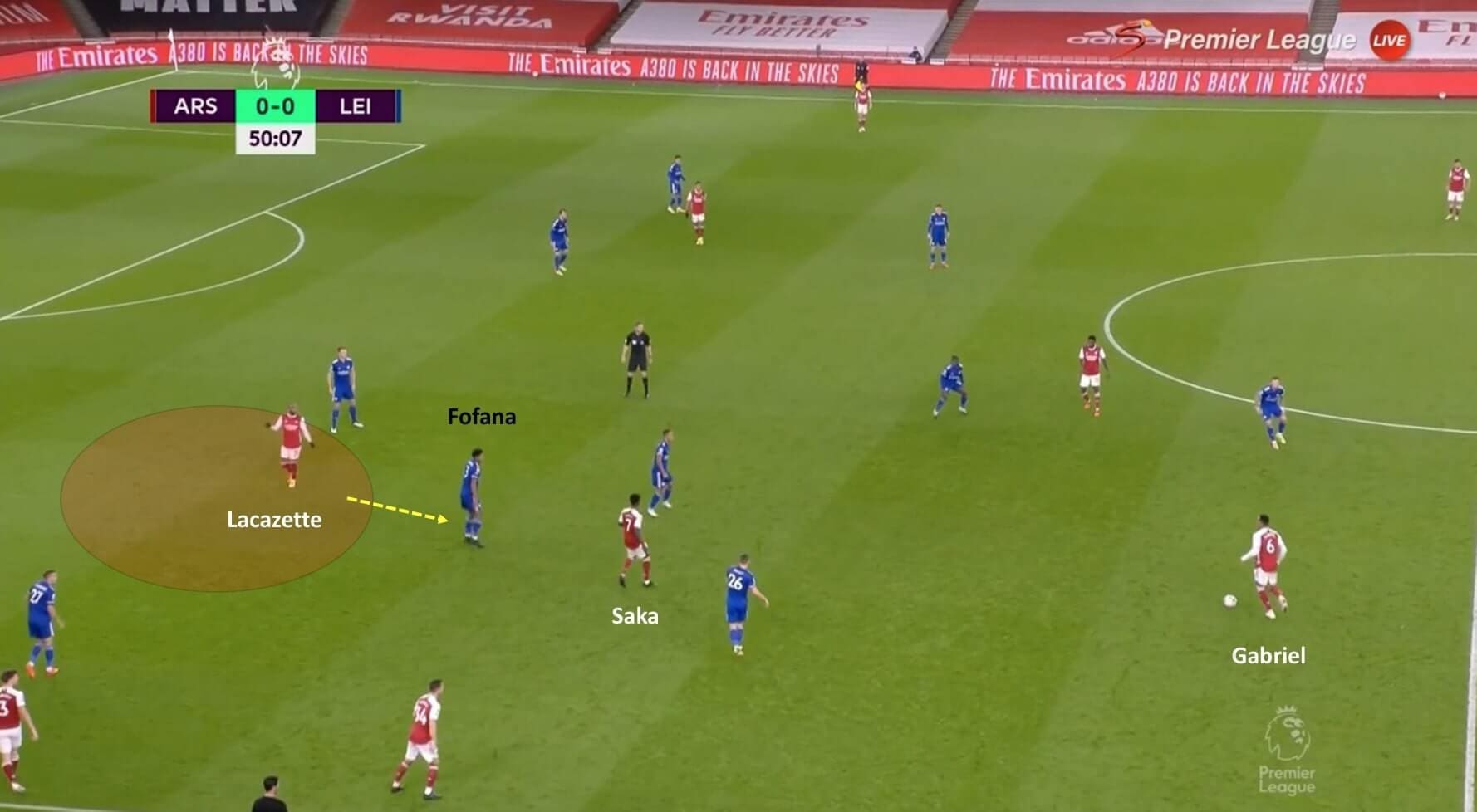
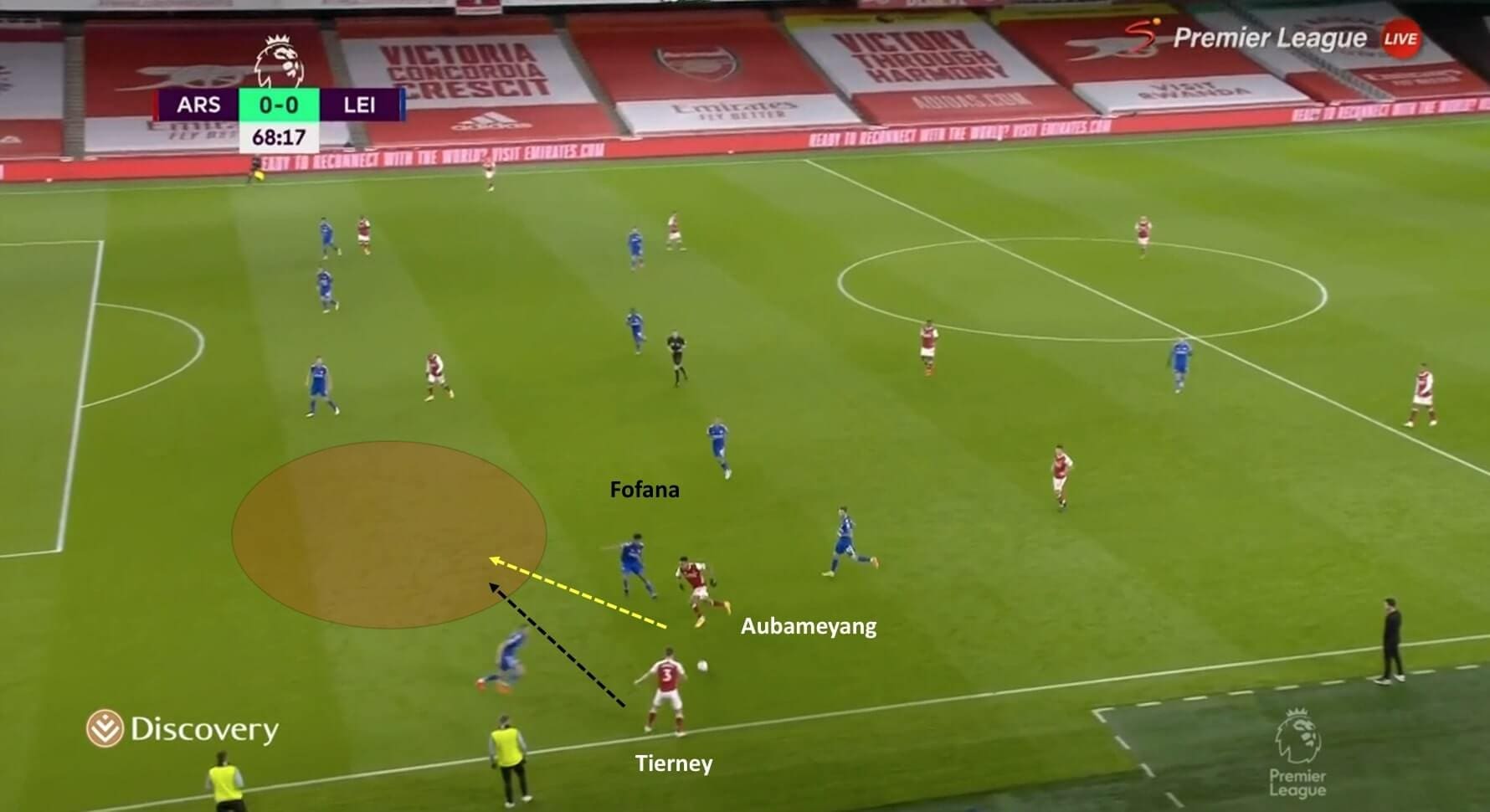
In spite of their attempts, the Gunners could only create merely one shot after Luiz’s departure which highlighted the lack of execution in the final third.
Jamie Vardy – the game changer
Rodgers’ game plan had worked so far as his pragmatic approach towards the game was evident before and after Vardy’s introduction. While he set his team up defensively before Vardy’s arrival (as shown in the previous section), Leicester’s game plan changed after their talisman entered the field. They started playing out from the back as their possession increased from 42% to 48%. Not only that, Vardy’s work-rate and intensity allowed his team to counter-press when they lost the ball in the final third, which was evident from the fact that their PPDA dropped from 34.2 to 23.4.
Having said that, it was not only a mentality shift amongst the players that Leicester started to look a better side. It had to do primarily with the tactical side of things. Vardy provided Leicester with a much-needed verticality in their attacks which was lacking while Barnes was playing as the striker. When a team does not have vertical height, it allows the opponent to stay vertically compact in the defensive phase, thereby making it difficult to create penetration in the final third.
Barnes, who is naturally a midfielder, couldn’t provide the vertical height like a recognized number ‘9’. Hence, Leicester had zero shots on goal and zero chances during the first-hour mark. For the remaining thirty minutes while Vardy was on the pitch, the visitors created two chances, had two shots on goal, and scored the winning goal. Much of this relied on the verticality that the 33-year old provided. Observe the positions of Vardy and Barnes in the following position map.
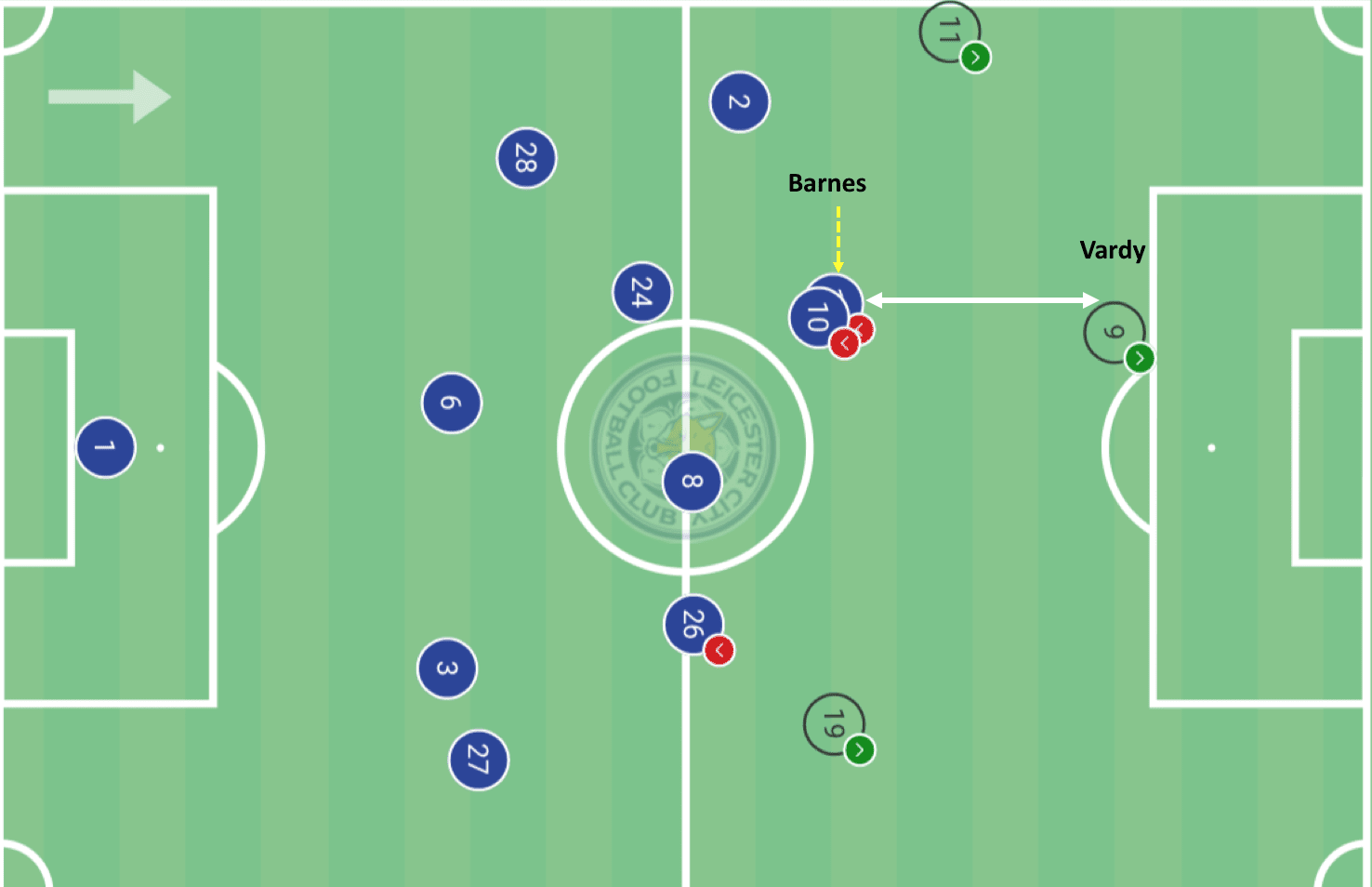
With Vardy stretching the defensive line of Arsenal, Maddison started to drop deeper to draw Arsenal’s midfield line higher. Consequently, it stretched the defensive and midfield lines of the hosts which created space between them, as shown in the following figure.
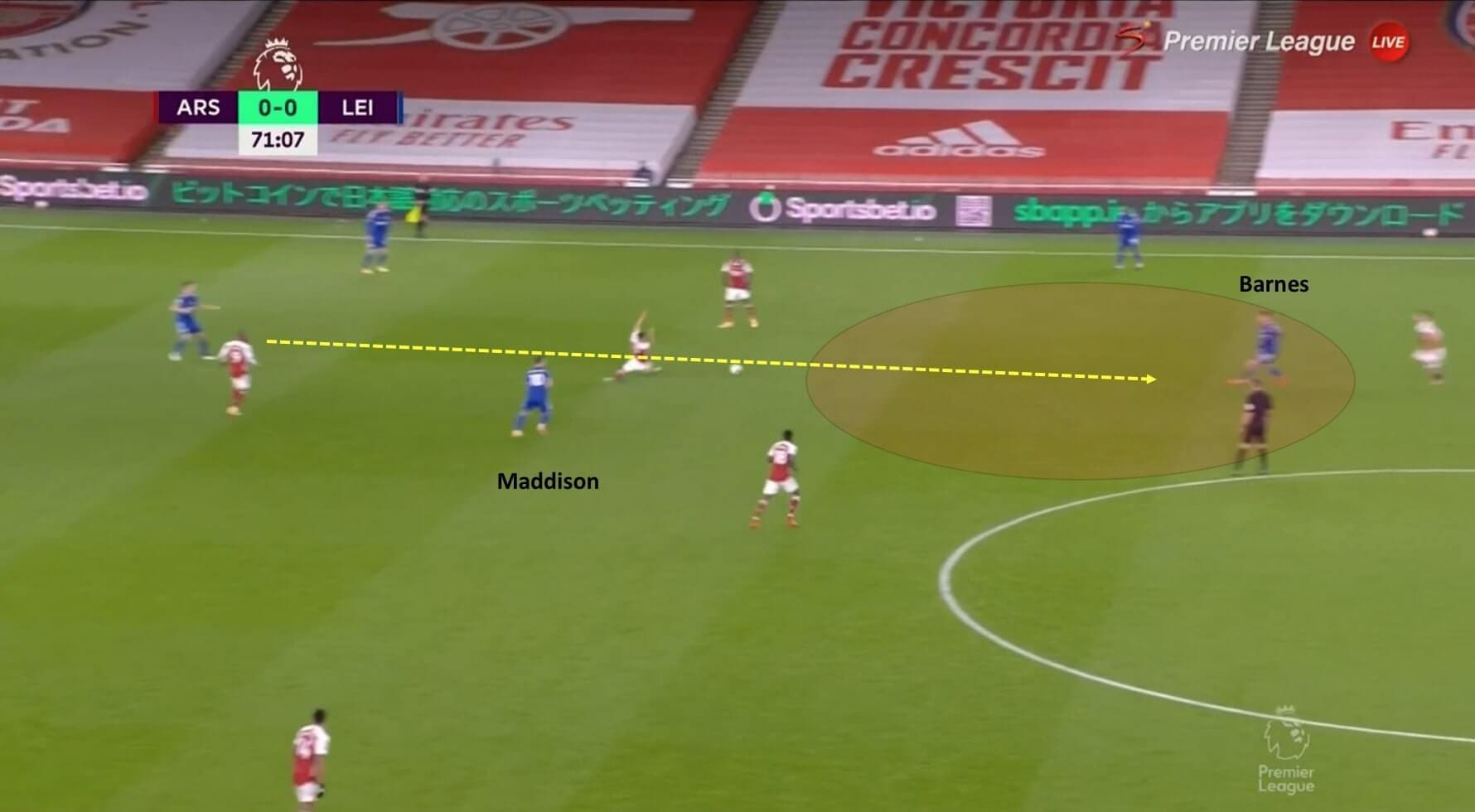
The image highlights Maddison’s deep movement as Vardy (not in the image) stretched the defensive line of Arsenal consequently creating space between them which Barnes looked to expose.
Vardy’s arrival allowed Barnes, who shifted to his favored left position, to come into the game for the first time. While the 22-year old was isolated in the first 60 minutes as he had merely 17 touches, the England national had 11 touches in the next 15 minutes before he was substituted.
Along with Barnes, Tielemans also grew into the game after Vardy’s introduction. The Belgium international likes to provide penetrating balls from the deeper areas when he is provided the space and time. Before Vardy, Leicester’s passive attacking approach meant that they did not have players to make runs beyond Arsenal’s backline.
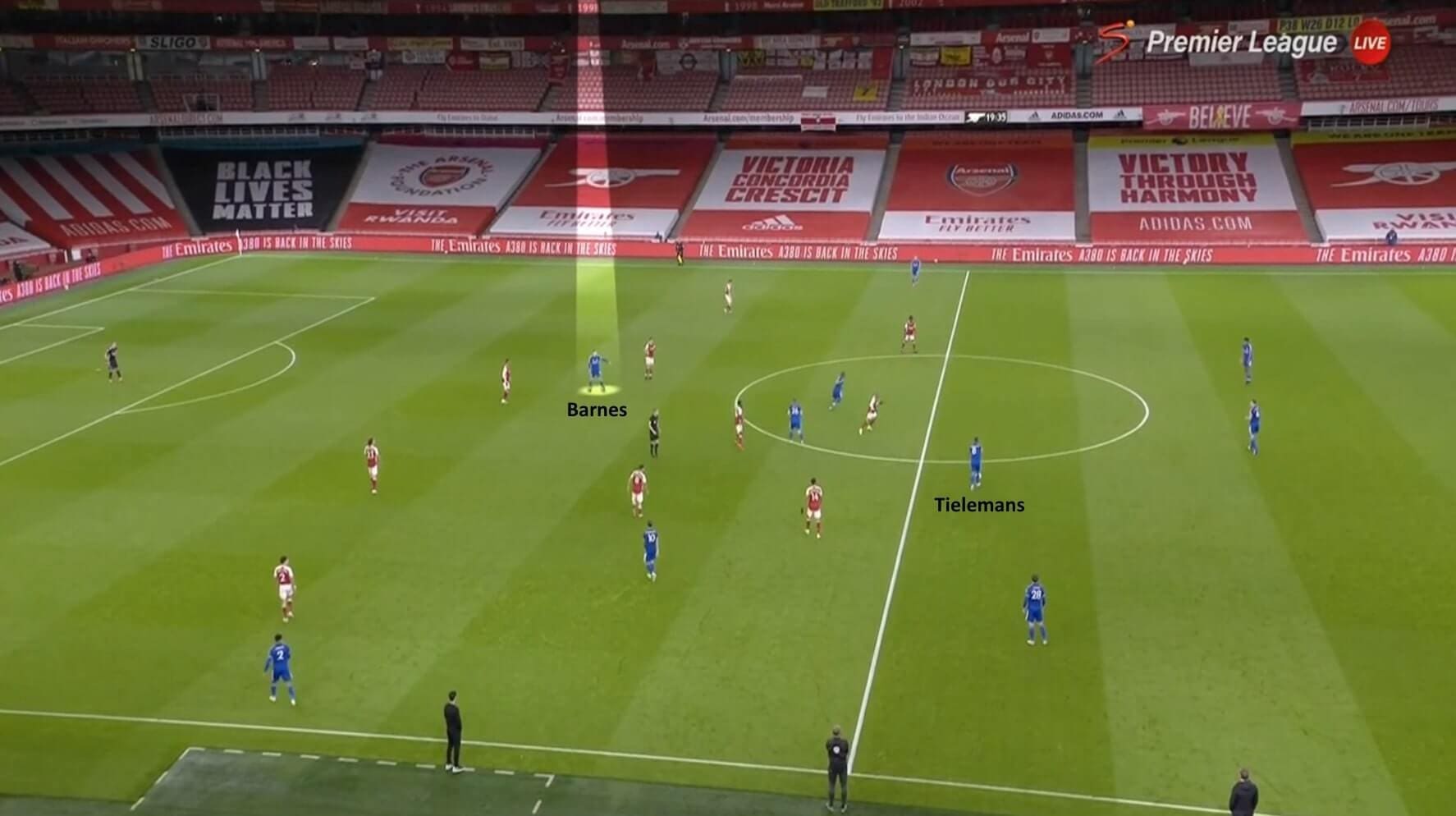
As shown in the figure above, Barnes is the only payer providing vertical height but he is not positioned well enough to make runs beyond the backline. Hence, Tielemans, who is on the ball, couldn’t penetrate from his own half.
Now consider the following figure, which was the movement that created the winning goal. As Tielemans received the ball in the defensive half, he had players making runs beyond the backline. Hence, the 23-year old put a ball for the substitute Cengiz Ünder in the half-space. The Turkish international provided a cross from within the box for Vardy, who headed his team to victory.
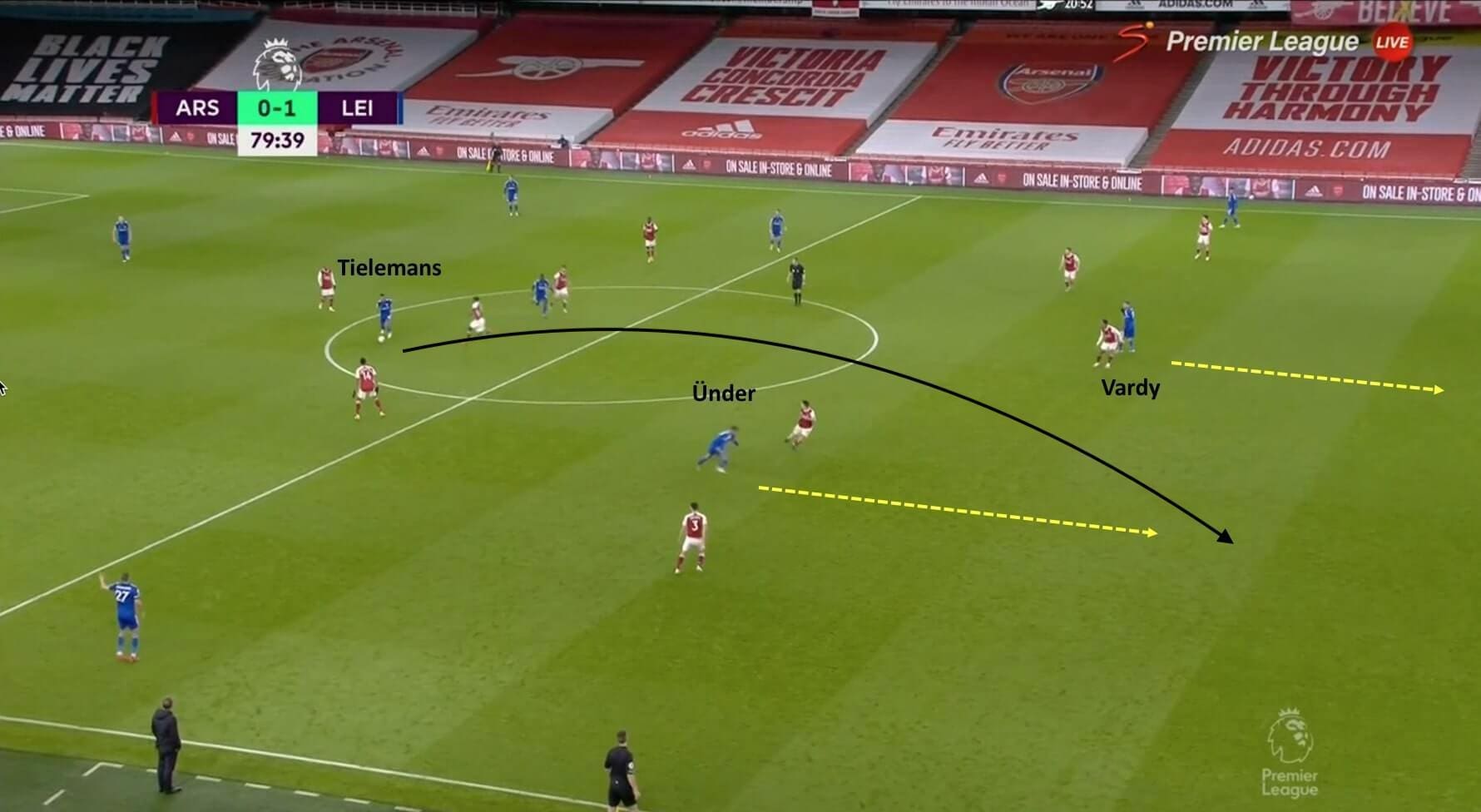
Final remarks
To conclude our analysis, Rodgers had viewed the game in two halves, which is pre-Vardy and post-Vardy. While the pre-Vardy tactics were all about resisting Arsenal’s attack and going to the final phase of the game without conceding, the post-Vardy tactics were to take the game on the hosts and try to convert one point into three. Albeit it was a risky prospect, it worked seamlessly as his players executed the plan to perfection to get a 1-0 win.
Arsenal, on the other hand, have now scored only eight goals in their six league games which highlights the creative concerns within the team. The issue was evident in today’s game as the Gunners lacked the imagination to break Leicester’s low-block. Most of their attacks came through Luiz and it is never a healthy sign when the creativity comes from a centre-back. Arteta needs to forget the loss early as their next league game is against Manchester United, who has started to gain momentum.





Comments